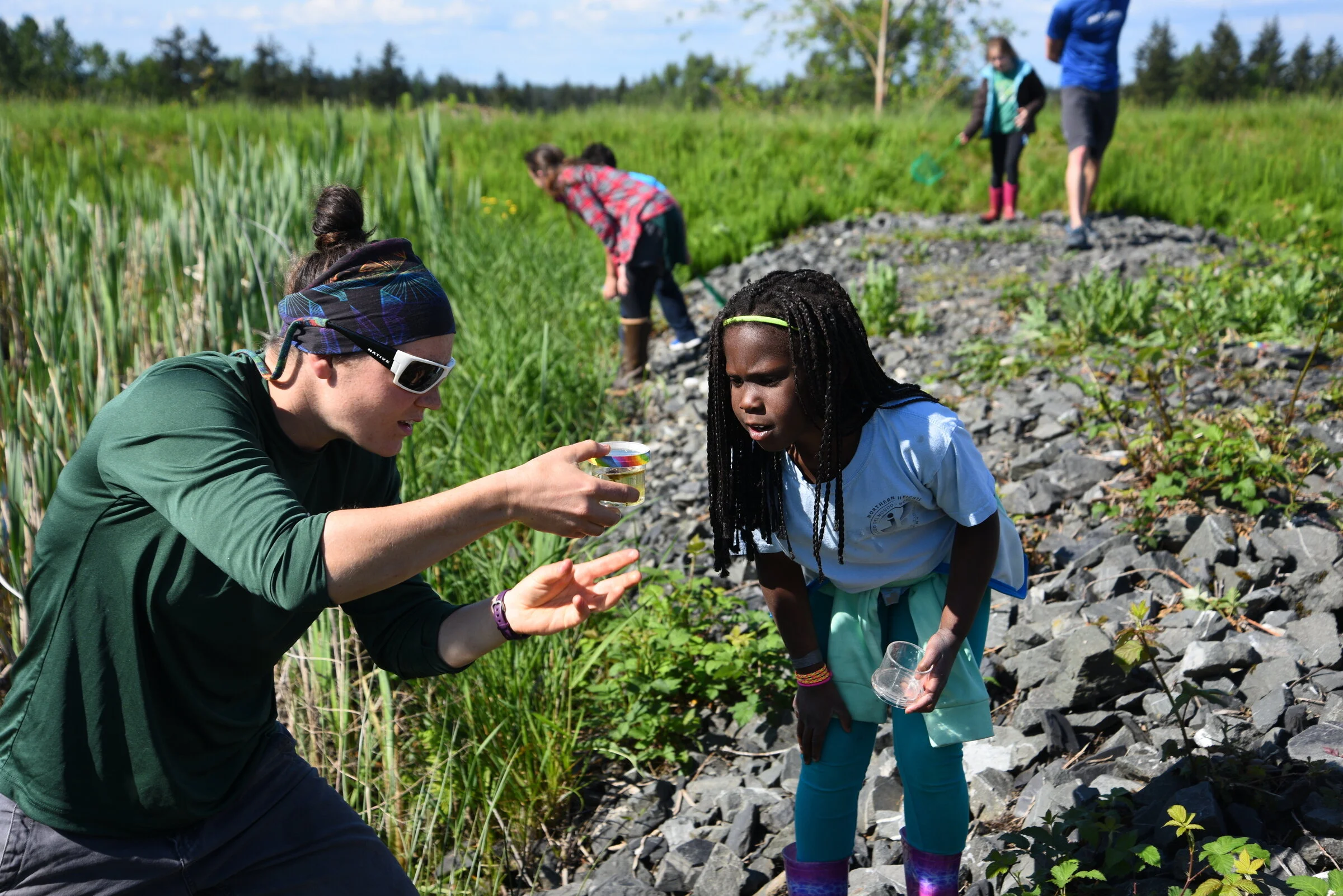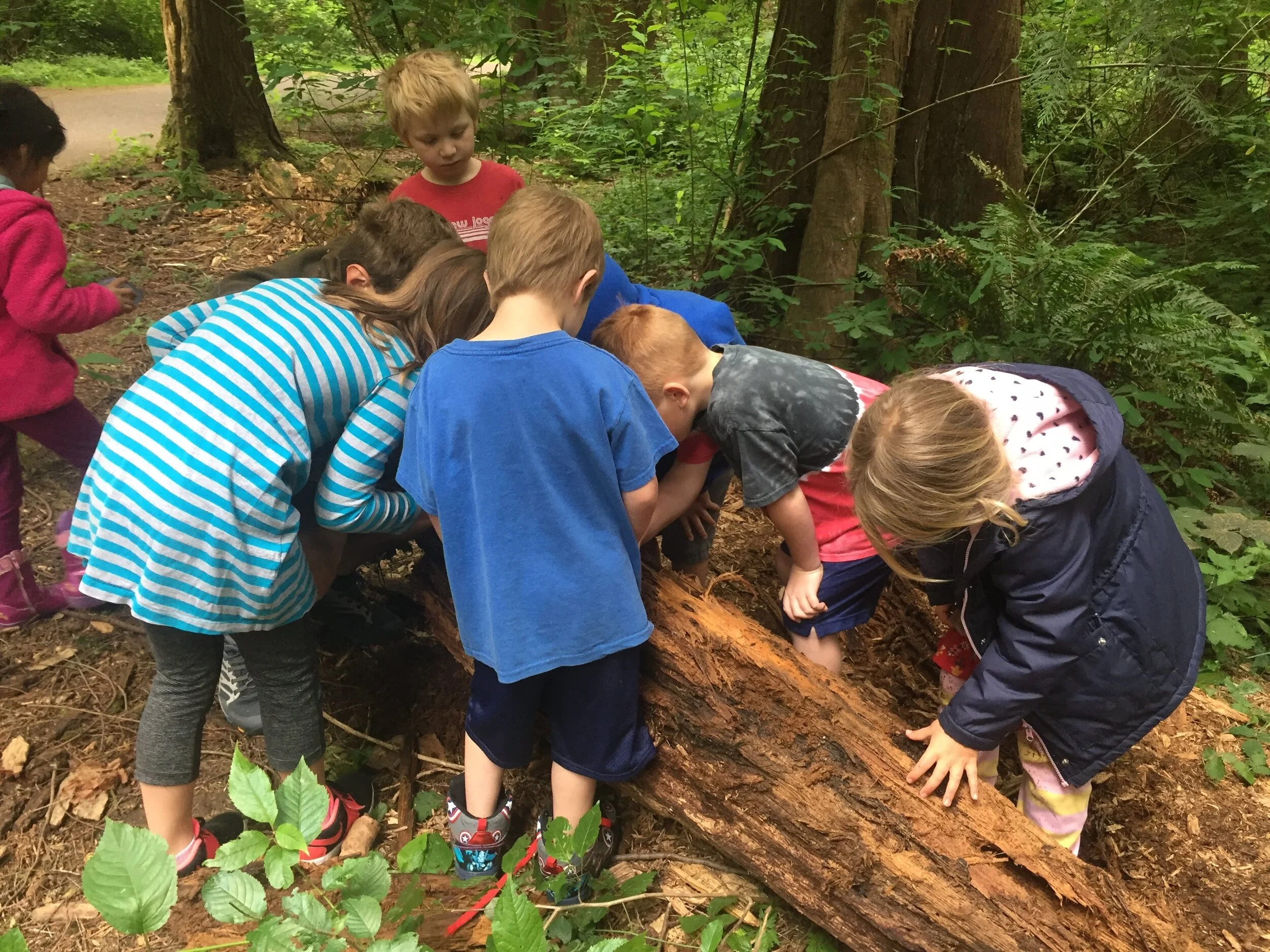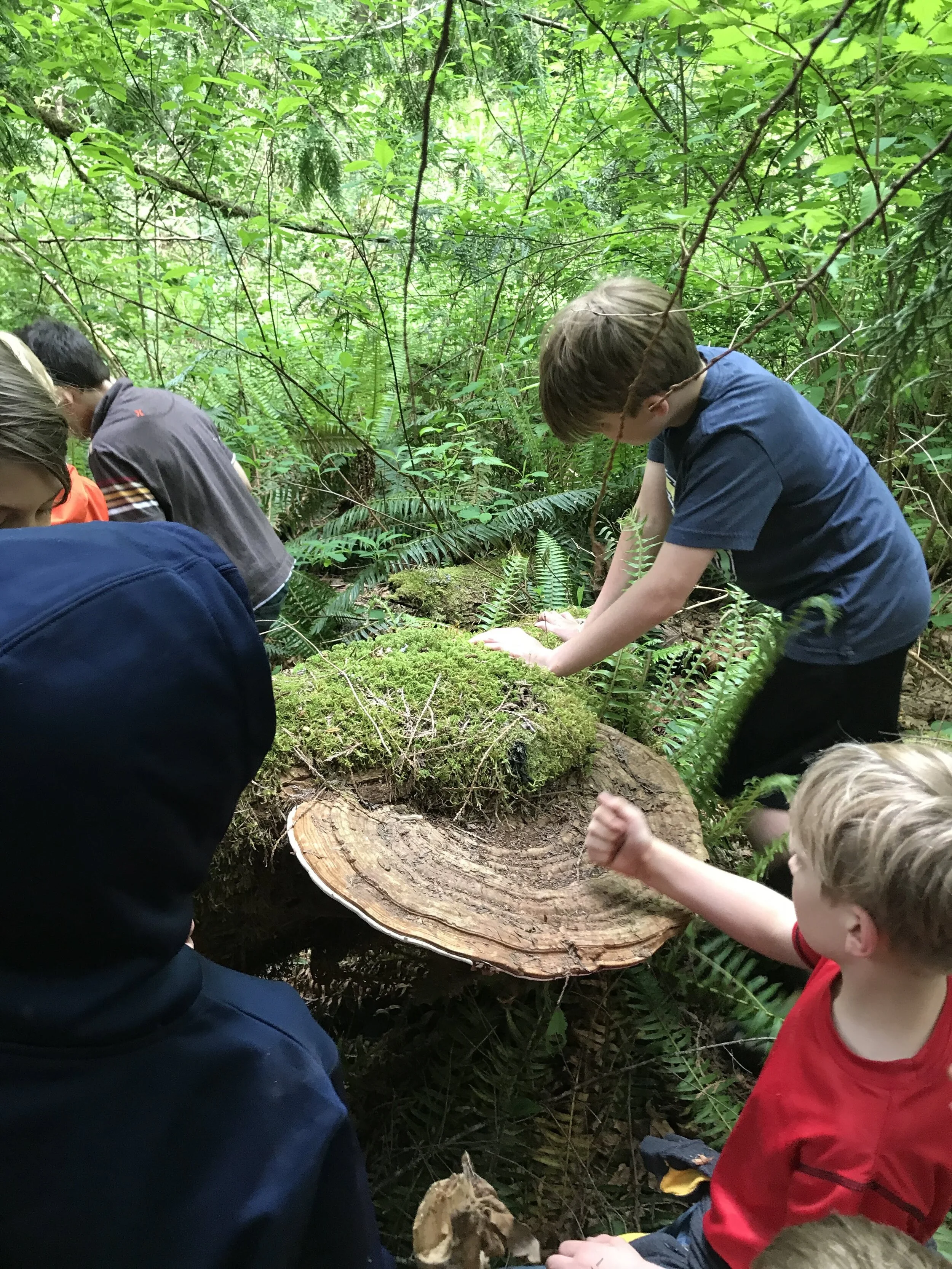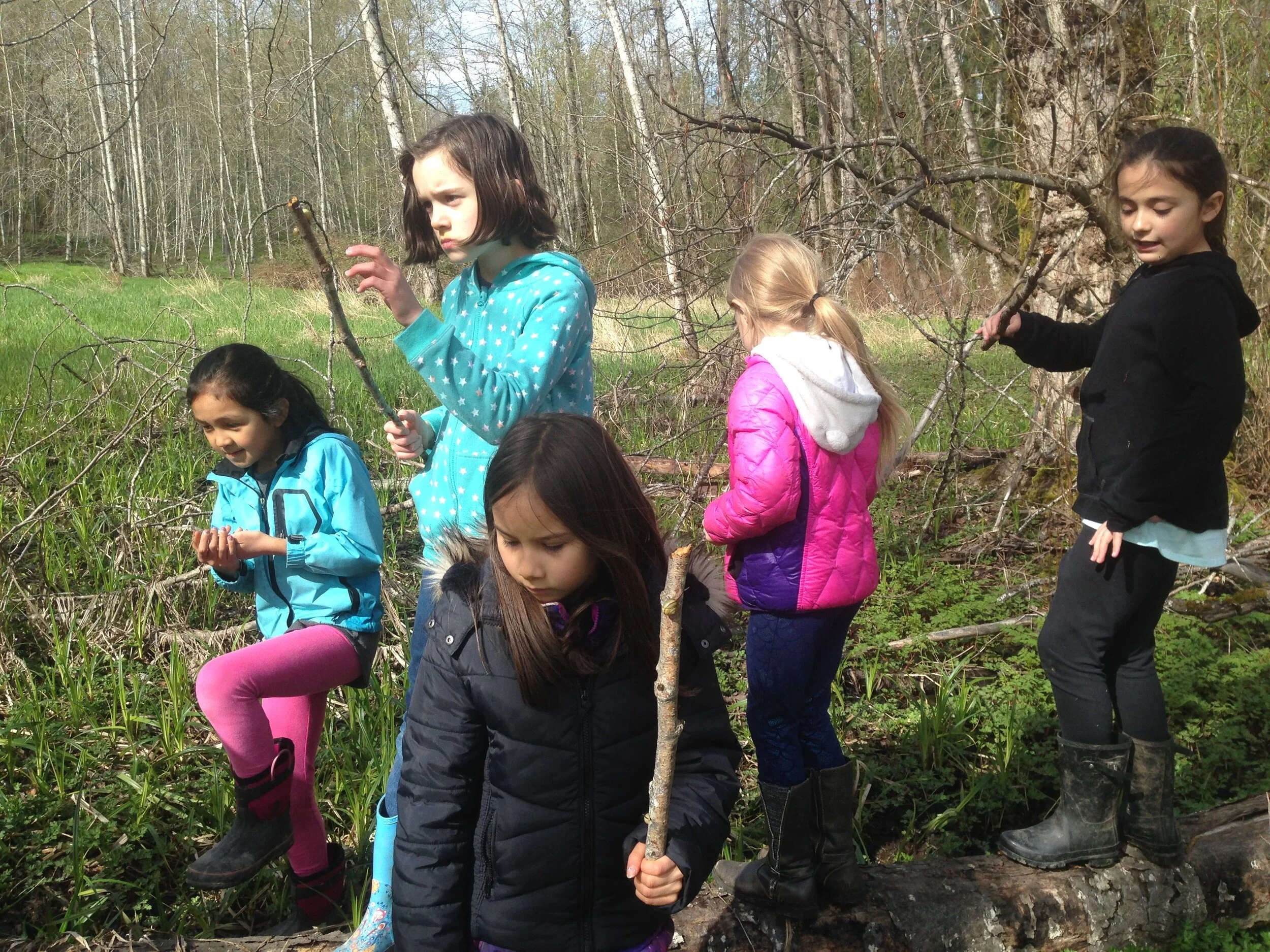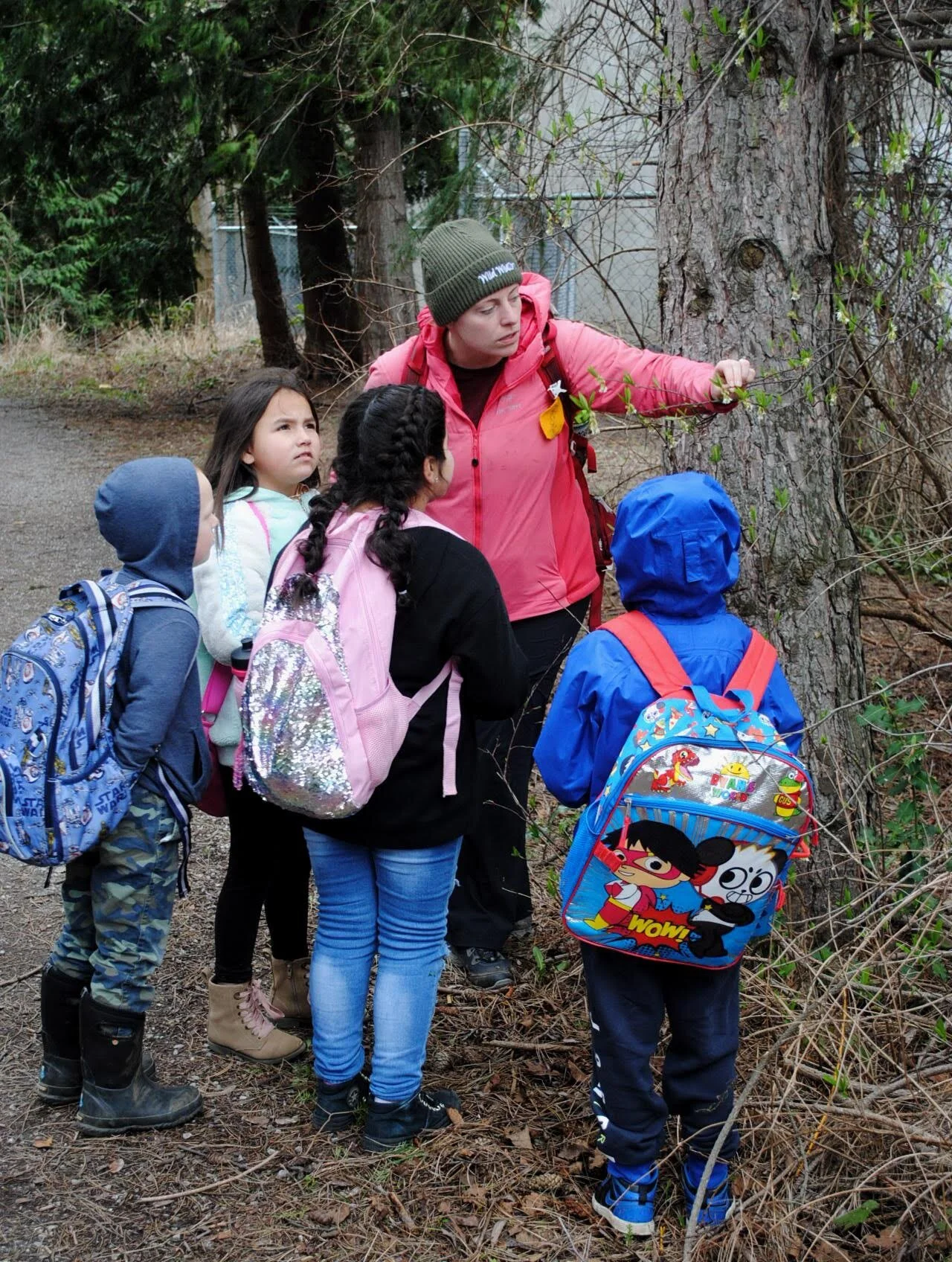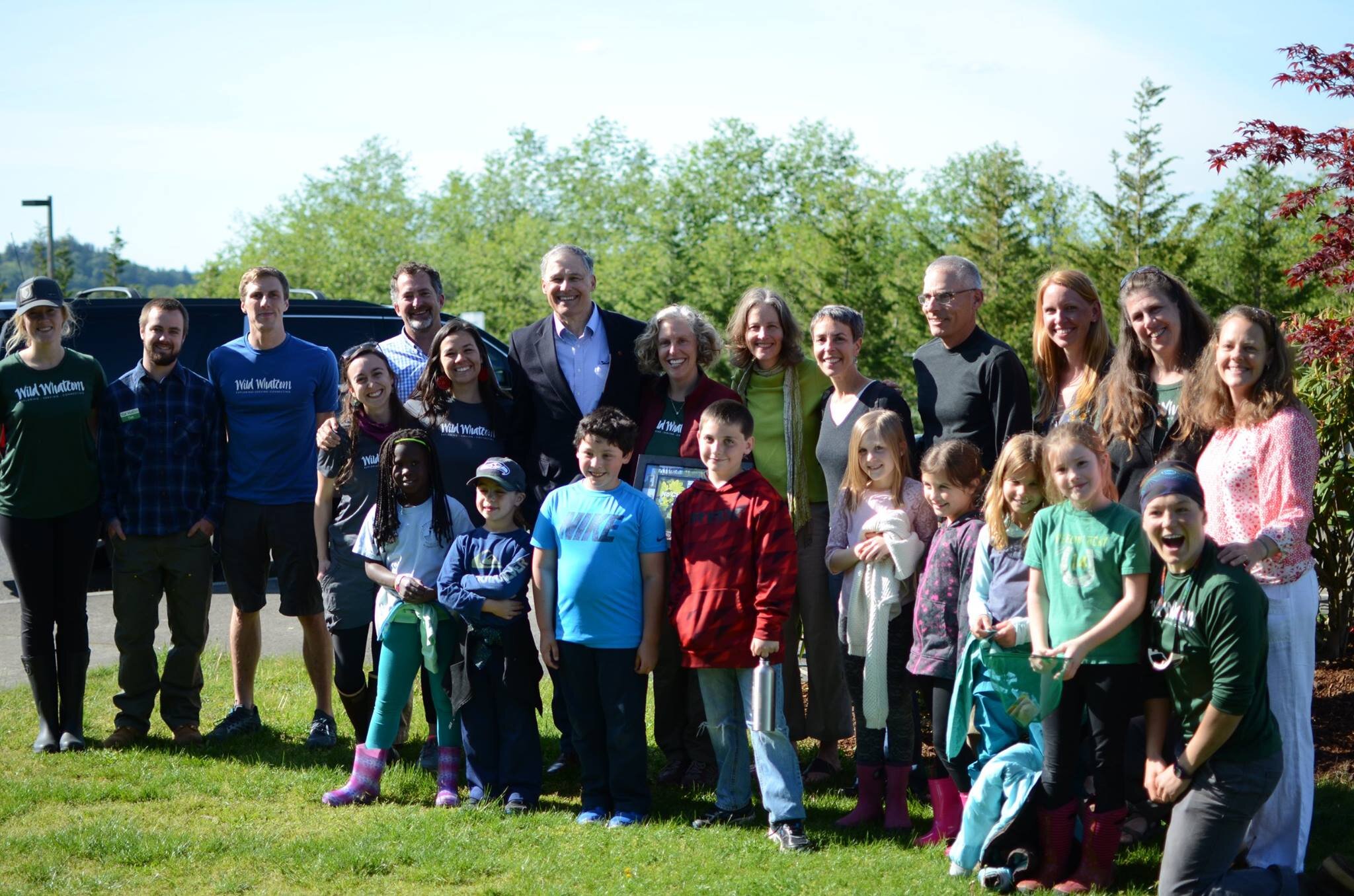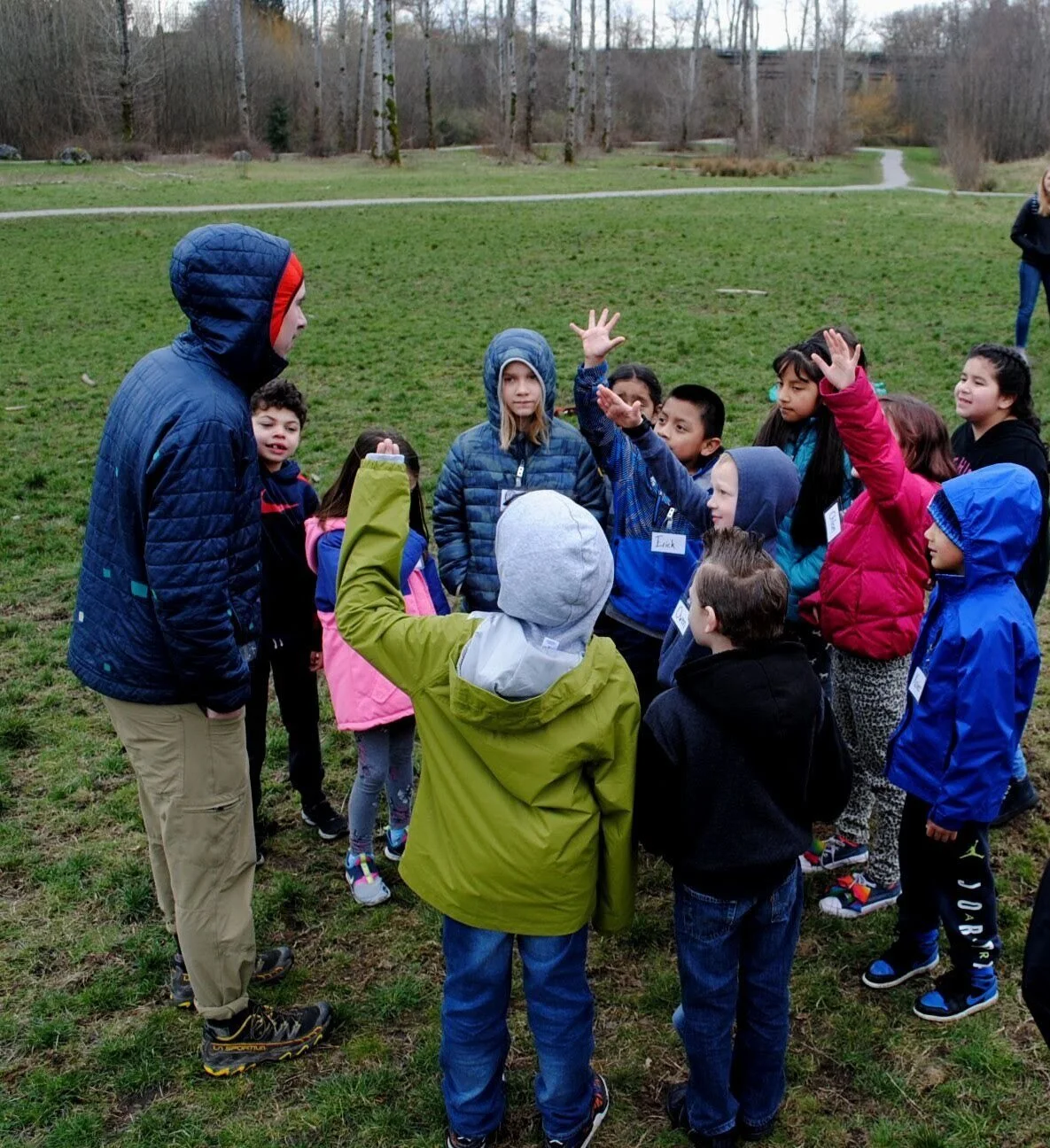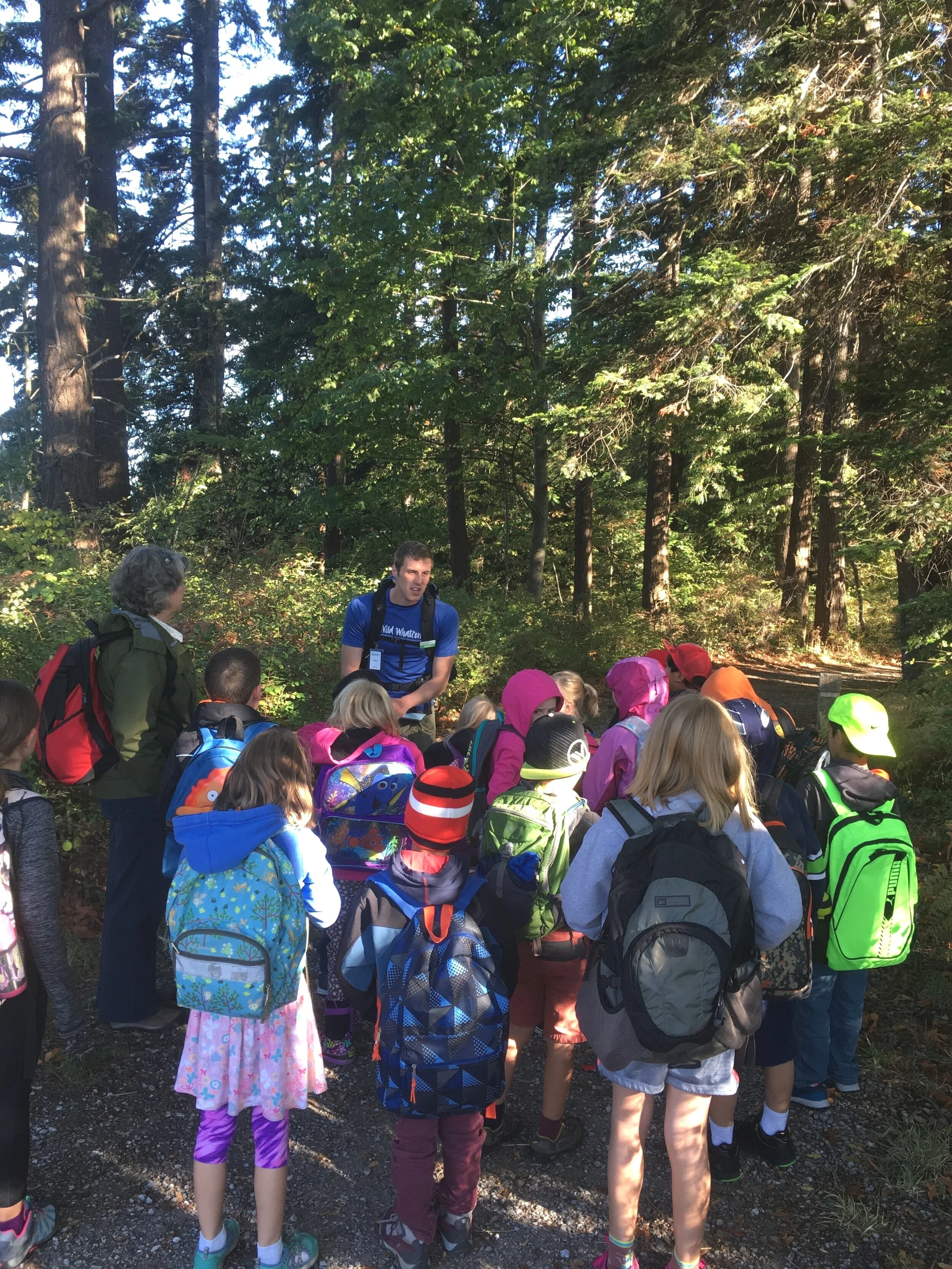EdVentures
We work with public school teachers to integrate this program into the school day. Students do not register directly for this program.
Collaborating with Grade 1-3 teachers, we create field outings that provide opportunities for classroom learning to come to life in the outdoors! Our approach includes scientific content such as observation, habitats, and stewardship experienced in the Wild Whatcom way: through hands-on activities, getting your hands dirty, fostering a sense of wonder and curiosity, mindfulness, and reflection.
We raise funds from donors, sponsors, and foundations to offer this program free to public schools, teachers, parents, and students. Want to support this work?
“Wild Whatcom provides opportunities that some of my students may never experience otherwise. ”
Standards-aligned outdoor lessons
EdVentures outings align with the Next Generation Science Standards and the Common Core Standards that students are learning and experiencing in their classrooms. We offer a series of 3-4 EdVentures outings within classrooms in Grades 1-3 over the course of a school year, scaffolding learning with activities that build on each other.
Wild Whatcom’s outdoor EdVentures program partners with Title 1 schools in Bellingham Public Schools, elementary schools in the Mount Baker School District, community non-profits, the City of Bellingham Parks and Recreation and Whatcom County Parks in an effort to bring the health, wellness, and academic benefits of time spent outdoors to students furthest from opportunity in Whatcom County.
EdVentures also empowers teachers to begin integrating outdoor lessons into their curriculum, with a focus on standards alignment and place-based and socio-emotional learning, to create well-rounded educational opportunities for under-served students.
Teachers: learn more about program learning goals and logistics.
“The EdVentures program has been highly impactful for my 2nd graders. The students from our school come from families who are experiencing housing insecurity and poverty. Many students had never been to Locust Beach even though they live right next to it. The learning experiences provided by EdVentures are very important to my students”
FUNDERS AND SUPPORTERS
This program is entirely funded through grants, sponsorships, and donations. We are grateful to our community of donors and funders who help to bring more underserved students outdoors to learn, play, and grow! Past funders have included:
This program was one of the first to receive funding through the statewide No Child Left Inside initiative. To celebrate this success, we got a special visit from Governor Inslee!
Governor Inslee visits our team in 2015 to celebrate the No Child Left Inside grant award that helped us launch this program.
GET INVOLVED
Are you inspired by this program? Consider a donation today!
Do you have any questions, would like to fund or sponsor this program, or are a Grade 1-3 teacher hoping to participate? Reach out to our School Programs team at schoolprograms@wildwhatcom.org.
Why we invest in EdVentures
Need and Opportunity
Since the onset of the COVID-19 pandemic and associated school closures and economic downturn, more and more research demonstrates the disproportionate impacts felt in low-income and minority communities. This has manifested in a variety of ways including, but not limited to, increased risk of falling behind academically and increased risk of mental health concerns.(1) Furthermore, even prior to COVID-19, students were increasingly spending time indoors, sedentary, and on screens, creating concerns about the mental and physical wellness of America’s youth; these trends have only increased since school closures and remote learning.(2)
Researchers are starting to demonstrate the need for increased time and activity outdoors for young people as we, as a society, begin to understand how to address rising concerns for the mental health and well-being of children and young people due to COVID-19.(3)
We believe that the integration of outdoor education into traditional schooling can be a lasting and impactful solution to help students heal, reinvigorate learning and academic achievement, and, given our target demographic, begin to address the historic and ongoing disparities in access to outdoor recreation, natural spaces, enrichment, and hands-on learning opportunities that can help students succeed.
“Providing our students with additional mentoring by Wild Whatcom educators is an exciting opportunity to create a lasting and positive shift away from the toxic stress that many of our children experience. It’s a wise and hopeful investment into our city’s most vulnerable children. ”
Academic success and post-COVID-19 wellness
Spending time outdoors during school can also support increased academic achievement. A recent analysis by Frontiers in Psychology confirms that “experiences with nature do promote children’s academic learning and seem to promote children’s development as persons and as environmental stewards.”(4) Furthermore, a 2017 systematic review of published research of regular compulsory school- and curriculum-based outdoor education programs found that they promote students’ social, academic, physical, and psychological development.(5)
An integration of additional outdoor activities and lessons into traditional schooling can also provide the documented mental and physical wellness benefits from time spent outdoors to students as they return to classrooms; this is particularly important for students disproportionately impacted by COVID-19, who are also disproportionately excluded from or face barriers to access outdoor enrichment and education.
Time in nature is not only associated with higher levels of physical activity, but is also linked with evidence-based health benefits including reduced stress, improved mental health, increased prosocial behavior and connectedness, and improved cognitive and motor development, many of which also help students to thrive in academic settings.(6) Locally, even before COVID-19, research shows that many residents of Whatcom County faced significant poverty, toxic stress, and disconnection—all of which lead to poor health outcomes and can prevent success in the classroom.(7)
“Wild Whatcom brings the classroom outside. It combines a love and respect of nature with hands on learning. The kids engage with the outside world and gain a better understanding of it. Wild Whatcom links the science standards we are learning in the classroom to the activities the students participate in on our field trips. Each of the three lessons build upon each other. ”
Disparate need and target demographic
Not all students have equal access to enrichment, academic resources, or time in nature. Integration of outdoor education into schools can reduce persistent access barriers such as cost, transportation, lack of comfort in the outdoors, and lack of appropriate gear.(8,9) EdVentures works to reduce this known “nature gap,” a disparity in access to outdoor time, to improve health, wellness, and academic success for under-served youth in our community.
For example, 52% of the Mount Baker School District (MBSD) student body qualifies for free and reduced lunch and 28% are youth of color. Communities in the district experience high levels of poverty, such as Glacier, ranking last of 522 areas in the state for household income with a median household income of $18,858 in 2019. Other towns in the district have high populations of families of color, such as Deming, home to the federally recognized Nooksack Tribe. The MBSD student population ranks in the bottom 50% in math and reading proficiency, 13% are English Language Learners, and the graduation rate has decreased by 10% in the past five years.(10)
Similarly, Carl Cozier Elementary, one of our targeted Title 1 schools in the Bellingham Public School Districts (BPS), serves a student body that is more than 50% non-white and receiving free or reduced-price meals.(11) Our EdVentures program is reaching students in Whatcom County who may be furthest from opportunities and need the most support as they begin returning to classrooms.
“We believe our students need a “sense of belonging and significance” to mitigate some of the effects of poverty and trauma. Edventures has become a valuable partner in our mission to provide students with meaningful learning experiences and opportunities to build strong relationships with mentors. We also believe that the peace and joy found in nature helps our students heal and grow healthy habits (curiosity, stewardship, mindfulness).”
Cited resources
1 - Lancker, Wim Van and Parolin, Zachary (2020). COVID-19, school closures, and child poverty: a social crisis in the making. The Lancet Public Health VOLUME 5, ISSUE 5, E243-E244. Doi: 10.1016/S2468-2667(20)30084-0; Don Bambino Geno Tai, Aditya Shah, Chyke A Doubeni, Irene G Sia, Mark L Wieland, The Disproportionate Impact of COVID-19 on Racial and Ethnic Minorities in the United States, Clinical Infectious Diseases, Volume 72, Issue 4, 15 February 2021, Pages 703–706, https://doi.org/10.1093/cid/ciaa815; and Golberstein E, Wen H, Miller BF. Coronavirus Disease 2019 (COVID-19) and Mental Health for Children and Adolescents. JAMA Pediatr. 2020;174(9):819–820. doi:10.1001/jamapediatrics.2020.1456, among others
2 - Barnett TA, Kelly AS, Young DR, Perry CK, Pratt CA, Edwards NM, Rao G, Vos MB; on behalf of the American Heart Association Obesity Committee of the Council on Lifestyle and Cardiometabolic Health; Council on Lifelong Congenital Heart Disease and Heart Health in the Young; and Stroke Council. Sedentary behaviors in today’s youth: approaches to the prevention and management of childhood obesity: a scientific statement from the American Heart Association [published online ahead of print August 6, 2018]. Circulation. DOI: 10.1161/CIR.0000000000000591 and Bates LC, Zieff G, Stanford K, Moore JB, Kerr ZY, Hanson ED, Barone Gibbs B, Kline CE, Stoner L. COVID-19 Impact on Behaviors across the 24-Hour Day in Children and Adolescents: Physical Activity, Sedentary Behavior, and Sleep. Children. 2020; 7(9):138. https://doi.org/10.3390/children7090138, among others
3 - Cowie, H., Myers, C., (2020). The impact of the COVID-19 pandemic on the mental health and well-being of children and young people. Children and Society. DOI: http://dx.doi.org/10.1111/chso.12430 and de Figueiredo, C. S., Sandre, P. C., Portugal, L. C. L., Mazala-de-Oliveira, T., Chagas, L. D. S., Rainy, I, Ferreira, E. S., Giestal-de-Araujo, E., dos Santos, A. A., Bomfim, P. O., (2021). COVID-19 pandemic impact on children and adolescents’ mental health: Biological, environmental, and social factors. Progress in Neuropsychopharmacology and Biological Psychiatry, 106 DOI: http://dx.doi.org/10.1016/j.pnpbp.2020.110171, among others
4 - Kuo M, Barnes M and Jordan C (2019) Do Experiences With Nature Promote Learning? Converging Evidence of a Cause-and-Effect Relationship. Front. Psychol. 10:305. doi: 10.3389/fpsyg.2019.00305
5 - Becker, C., Lauterbach, G., Spengler, S., Dettweiler, U., & Mess, F. (2017). Effects of Regular Classes in Outdoor Education Settings: A Systematic Review on Students' Learning, Social and Health Dimensions. International Journal of Environmental Research and Public Health,14(5), International journal of environmental research and public health, 05 May 2017, Vol.14(5).
6 - Bølling, M., Niclasen, J., Bentsen P., Nielsen, G., (2019). Association of Education Outside the Classroom and pupils' psychosocial well-being: Results from a school year implementation. Journal of School Health, 89, 210-218. DOI: http://dx.doi.org/10.1111/josh.12730
7 - Newell, Astrid (2016). Strategies for Child and Family Health Policy. Whatcom County Health Department Health Board Presentation to the Whatcom County Council, Nov 1, 2016 (page 15). Presentation available at: http://www.whatcomcounty.us/DocumentCenter/View/23164/Health-Board-Agenda-Packet-November-1-2016?bidId=
8 - Nesbitt, et. al. (2019). Who has access to urban vegetation? A spatial analysis of distributional green equity in 10 US cities. Landscape and Urban Planning Jan 2019, 181 (51-79). Doi: https://doi.org/10.1016/j.landurbplan.2018.08.007
9 - Reis, A.C., Thompson-Carr, A., Lovelock, B., (2012). Parks and families: Addressing management facilitators and constraints to outdoor recreation participation. Annals of Leisure Research, 15(4), 315 - 334. DOI: http://dx.doi.org/10.1080/11745398.2012.737299
10 - Public School Review. Mount Baker School District data. Available at: https://www.publicschoolreview.com/washington/mount-baker-school-district/5305310-school-district
11 - National Center for Education Statistics. Search for Public Schools. Carl Cozier Elementary School data. Available at: https://nces.ed.gov/ccd/schoolsearch/school_detail.asp?Search=1&DistrictID=5300420&ID=530042000101


